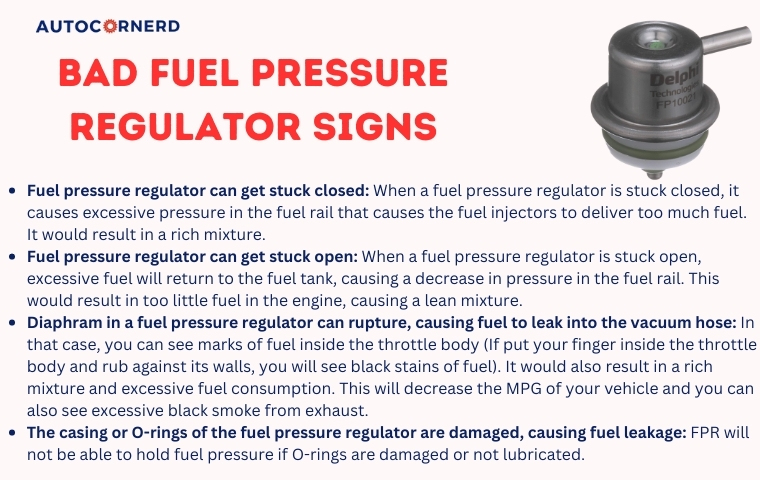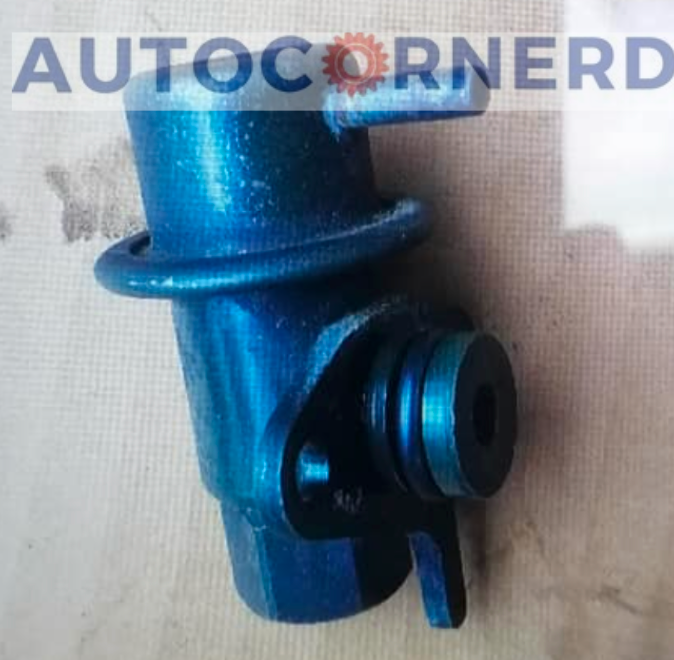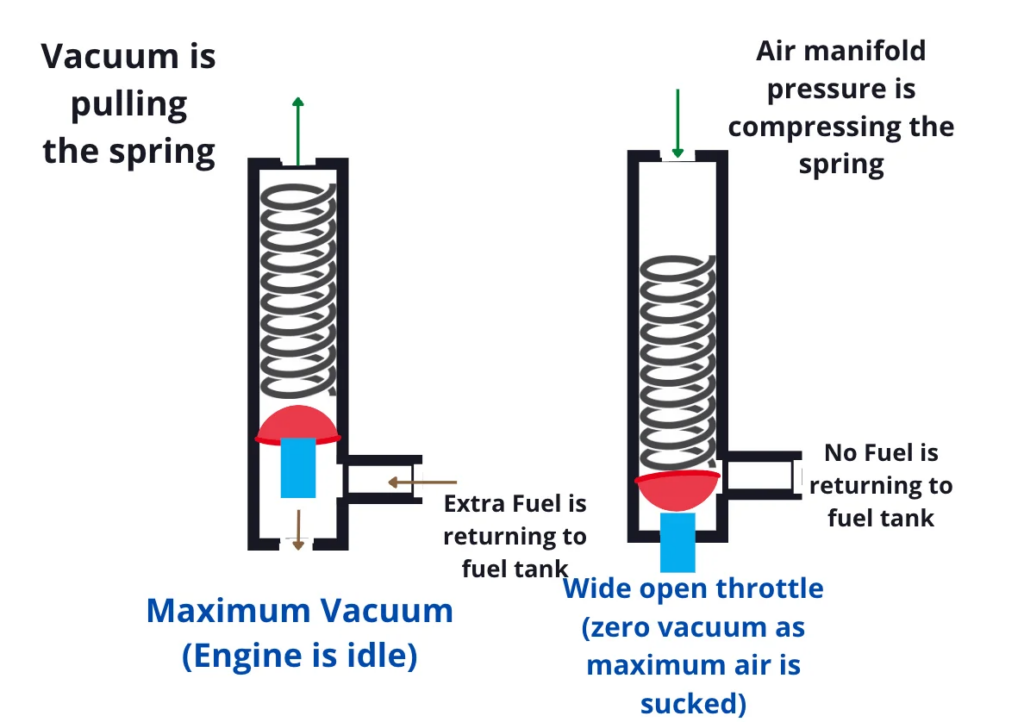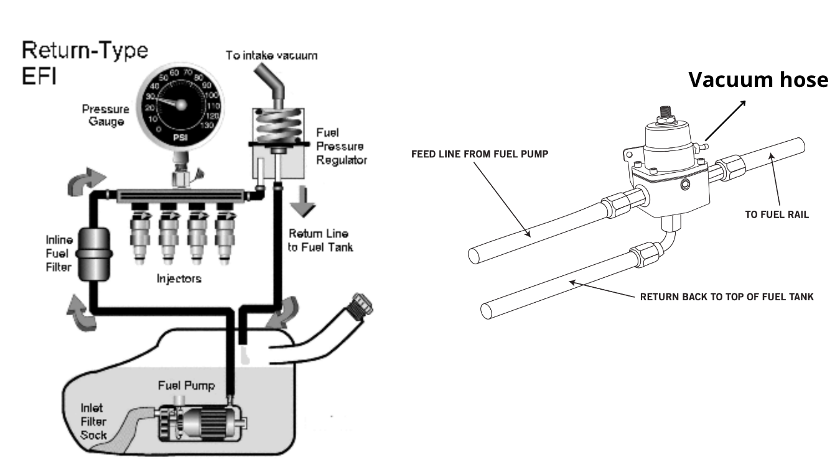12 Symptoms Of A Bad Fuel Pressure Regulator: Car Sputtering and Diagnostic Tests!
A faulty fuel pressure regulator can cause quite a few problems for your vehicle. The most common symptoms you may notice include: loss of power when trying to accelerate, black smoke coming from the exhaust pipe, a rough idle, meaning the engine vibrates more than normal when sitting still, fuel detected in the vacuum line, difficulty starting the engine, reduced fuel economy, the check engine light coming on and engine misfires. A bad fuel pressure regulator can result in trouble codes like P0171, P0300, P0175 or P0172. You can read these with an OBD-II scanner. Replacing fuel pressure regulator typically costs between $100 and $500 including labor, depending on the vehicle’s make and model.
In this article, we will discuss the most common symptoms of a bad fuel pressure regulator that will help you understand the importance of your engine’s fuel system and why it is so crucial to ensure it is working properly.
If your fuel pressure regulator is bad, you will notice that you will lose power when you accelerate. So, read this guide till the end as I’ll uncover symptoms of a bad fuel pressure regulator and also discuss how fuel pressure regulator goes bad.
If you already have an idea about the exact working of the fuel pressure regulator, you can jump straight to the section on how a fuel pressure regulator goes bad.
- Check engine light illumination, black smoke from exhaust, fuel in vacuum line are signs of a bad fuel pressure regulator.
- Regulator maintains proper fuel pressure to injectors at all engine speeds. A failing regulator causes drivability issues.
- Regulator uses intake manifold vacuum to regulate fuel pressure. The vacuum controls the diaphragm of the fuel pressure regulator.
- Testing fuel pressure with gauge, checking for fuel in vacuum hose, trouble codes can diagnose bad regulator.
- Replacing faulty regulator typically costs $100-500+ for parts/labor. Proper maintenance prolongs regulator lifespan.
Here are the Symptoms Of Bad Fuel Pressure Regulator
- Illumination of the check engine light
- Consumption of more fuel than usual (reduced fuel mileage)
- Black smoke from the engine exhaust
- Sputtering of an engine
- Loss of engine power
- Fuel in the vacuum line
- Loss of vehicle acceleration or stalling of the engine when the pedal is depressed
- Rough idling of the engine
- Rough engine running or missing speed when trying to accelerate
- Hard Starting of engine
- Bad driving experience
- Fouling of spark plugs
- Fuel in the vacuum hose connected to the fuel pressure regulator

Why A Fuel Pressure Regulator Is Needed?
The demand for the fuel needed by the engine changes when the engine is running idle, accelerating, deaccelerating, or cruising at certain speeds.
The fuel pressure regulator regulates the amount of fuel delivered to the engine by adjusting the pressure at changing speeds i.e. at different throttles. This allows the fuel/air mixture to be perfect before entering the combustion chamber.
How Does A Bad Fuel Pressure Regulator Affect Engine Performance?
There are several key signs and symptoms that indicate a faulty fuel pressure regulator.
One early sign of a flawed fuel pressure regulator is the check engine light turning on. The ECU controls the check engine light. It lights up when the computer finds an issue that could raise emissions or hurt engine performance.
A faulty fuel pressure regulator often sets off diagnostic trouble codes (DTCs) linked to fuel delivery. For example, code P0191 means low fuel pressure. And P0193 flags high fuel pressure.
These codes tell us the computer saw weird fuel pressure readings outside the normal range. So if the check engine light shines along with fuel-related DTCs, it likely shows a problem with the fuel pressure regulator.
A clear sign of a failing fuel pressure regulator is worsening fuel economy. When the regulator starts to malfunction, it lets extra fuel pressure get to the injectors. This results in an overly rich fuel mixture.
A rich mixture has too much fuel compared to the amount of air. Because of the surplus fuel injected into the engine without burning, your fuel economy takes a hit.
Too much black smoke coming from the exhaust can be a sign of an overly rich fuel mixture. This can happen when the fuel pressure regulator is not working right. The regulator’s job is to control how much fuel gets to the injectors. If it fails, it will let too much fuel pressure get through.
With more fuel than it can handle, the engine cannot properly burn it all. This leaves extra unburned fuel that turns into black soot as it goes out the tailpipe. This sooty black smoke means the mixture has gone too rich.
The bad fuel pressure regulator is not keeping the fuel amount in check, overwhelming the engine. When you see an exhaust pouring out dark black smoke, it likely points to issues with the fuel pressure regulator.
When a fuel pressure regulator fails, you may notice the engine sputtering or hesitating when you try to accelerate. This is because the bad regulator cannot keep the fuel pressure right. So the mix of air and fuel gets thrown off balance.
When you hit the gas, the engine needs more fuel to match the rush of incoming air. A faulty regulator might not let the fuel pressure rise high enough. Without enough fuel, the air/fuel mixture becomes too lean. This lean mix means there is not enough fuel for full engine power. So the engine sputters and struggles to accelerate.
On the other hand, a broken regulator could also let the fuel pressure get too high. Here, the air/fuel mixture becomes too rich. It floods the engine with excess fuel. This leads to misfires and hesitation when trying to speed up.
Either way, if your engine starts sputtering when accelerating, the fuel pressure regulator is likely the problem part. It no longer keeps the ideal pressure needed for smooth speeding up.
As a fuel pressure regulator slowly fails, you may notice a big drop in engine power. The uneven fuel pressure makes it hard for the engine to work right.
Too much fuel pressure gives a rich mixture that can’t burn properly. Too little fuel pressure gives a lean mixture without enough energy. Both make the engine run weaker.
The loss of power is most noticeable when pushing hard on the gas, going uphill, or carrying heavy loads. As the problem gets worse, the engine will keep losing power more and more often.
The fuel pressure regulator controls the pressure of fuel sent to the injectors. For an engine to start properly, the injectors need just the right fuel pressure to spray the correct amount of fuel.
When the fuel pressure regulator allows too little fuel pressure, the engine might not get enough fuel to start. If the pressure gets too high, it can also make starting hard by flooding the cylinders with fuel.
You might notice the engine cranking but not starting. Or it may need longer cranking before it finally starts. If the engine has trouble starting sometimes but not always, that points to an issue with the fuel pressure regulator.
The fuel pressure regulator uses engine vacuum to help regulate fuel pressure (more on this later). There is a vacuum line running from the intake manifold to the regulator diaphragm. If the diaphragm ruptures, it will allow fuel to seep into the vacuum line.
Examining the regulator’s vacuum line provides a way to check for diaphragm failure. The presence of fuel in the line indicates the diaphragm has torn and will need replacement along with the regulator.
A fuel pressure regulator can foul the spark plug with the carbon deposits of the fuel if the fuel pressure regulator is stuck closed or its diaphragm is ruptured, causing fuel to leak into the air intake manifold.
When the fuel pressure regulator is stuck closed, too much fuel pressure is built up in the fuel rail. As a result, fuel injectors will inject excessive fuel that will not be properly atomized and burn in the presence of air. As a result, it will foul the spark plugs.
Similarly, when a stream of fuel directly leaks into the air intake manifold, it will also come into contact with the spark plugs and damage them.
When spark plugs become bad, engine misfire will take place. The check engine light might turn on and your engine might throw P0300 trouble codes.
You must read this PDF related to bad spark plugs signs and causes to learn more.
A bumpy or fluctuating idle speed can signal an issue with the fuel pressure regulator. The irregular fuel pressure is unable to hold a steady idle rpm.
Too much pressure leads to a rich mixture and rough idle as the engine struggles to burn the excess fuel. As pressure drops, idle smooths out. When pressure rises again, idle becomes rough. This erratic idle is a classic symptom of a faulty regulator.
Inconsistent fuel pressure from a bad regulator can cause random engine misfires as the cylinders receive varying fuel amounts. Too much pressure leads to fouled plugs and misfires from overly rich mixtures. Low pressure causes lean misfires from lack of adequate fuel.
These random misfires create perceptible drivability issues and rough running. Misfires tend to worsen as the problem progresses and fuel pressure drifts further from specification.
What Does A Fuel Pressure Regulator Do?

A fuel pressure regulator is a spring-loaded mechanical device that keeps consistent fuel pressure running through the fuel rail at all times. Cars with fuel injection need it because changes in fuel pressure affect their performance.
Fuel injectors just open and close based on signals from the ECU. The car’s ECU controls how much fuel gets squirted in by tweaking how long they stay open.
But the flow rate of fuel relies on having the right pressure in the fuel rail. So the ECU needs that steady fuel pressure to inject the right fuel amount.
When you turn the ignition key, the fuel pump runs a few seconds to build fuel pressure in the rail before the engine starts.
Working Of Fuel Pressure Regulator
The fuel pressure regulator is an important engine part. It makes sure the right amount of fuel flows to the injectors. The fuel pressure regulator does this by keeping the fuel pressure steady as engine conditions change.
When the engine idles, vacuum in the intake manifold is high. The throttle body is closed. The high vacuum lifts a diaphragm or valve inside the regulator. This allows extra fuel to flow back to the tank.
As you step on the gas, the throttle opens. This lets air into the manifold, lowering vacuum. The lower vacuum pushes the regulator diaphragm down. Now less fuel can return to the tank. Fuel pressure to the injectors stays right.

The fuel pressure regulator has a spring-loaded diaphragm. There’s a small vacuum hose from the intake to the regulator. One fuel line connects the tank to the regulator. Another goes from the regulator to the fuel rail.
When you accelerate, manifold pressure rises. This acts on the diaphragm against the spring. The regulator adjusts to keep ideal pressure at the injectors.

So the changing manifold pressure is the key. As it goes up or down, the regulator diaphragm moves. This keeps fuel pressure in the proper range. The engine gets just the right fuel flow it needs.
Do GDI Engines Have Fuel Pressure Regulator?
GDI engines (Gasoline Direct Injection Engines) do not have a fuel pressure regulator. Instead, they have a fuel pressure sensor.
GDI engines have fuel injectors inside the engine cylinder while multiport fuel injection systems have fuel injectors in the air intake manifold. GDI engines have two fuel pumps. One is near the fuel tank and the other is connected to the fuel rail.
The high-pressure fuel pump has a flow control valve that is controlled by ECM (Engine control module). The fuel pressure sensor sends signals of fuel pressure inside the fuel rail to the ECM.
The ECM sends electric signals to the flow control valve of the fuel pump to adjust the fuel pressure. That fuel pressure system is more reliable than a mechanically controlled fuel pressure regulator system.
How Does A Fuel Pressure Regulator Fail?
A fuel pressure regulator can fail in the following ways:
- Fuel pressure regulator can get stuck closed: When a fuel pressure regulator is stuck closed, it causes excessive pressure in the fuel rail that causes the fuel injectors to deliver too much fuel. It would result in a rich mixture.
- Fuel pressure regulator can get stuck open: When a fuel pressure regulator is stuck open, excessive fuel will return to the fuel tank, causing a decrease in pressure in the fuel rail. This would result in too little fuel in the engine, causing a lean mixture.
- Diaphram in a fuel pressure regulator can rupture, causing fuel to leak into the vacuum hose. In that case, you can see marks of fuel inside the throttle body (If put your finger inside the throttle body and rub against its walls, you will see black stains of fuel). It would also result in a rich mixture and excessive fuel consumption. This will decrease the MPG of your vehicle and you can also see excessive black smoke from exhaust.
- The casing or O-rings of the fuel pressure regulator are damaged, causing fuel leakage. FPR will not be able to hold fuel pressure if O-rings are damaged or not lubricated.
How To Diagnose A Bad Fuel Pressure Regulator?
You can identify issues with a bad fuel pressure regulator in the following ways:
- One method is to check the fuel pressure directly. You can do this by removing the vacuum hose from the fuel pressure regulator. Then see if the fuel pressure stays steady or drops off.
- Also inspect to see if any fuel leaks from the regulator itself. Seepage often signals a failing component.
- Inspect the spark plugs as well. Fouling or unusual deposits may indicate a problem with fuel mixture.
- Many vehicles today have onboard diagnostics. An OBD2 scanner can pull trouble codes that may point to regulator failure. However, the regulator itself does not set a specific error code.
- Use a vacuum pump (more on this later) on the fuel pressure regulator’s vacuum port. Watch the fuel pressure gauge when applying vacuum. The fuel pressure will go down as the vacuum will increase.
The Bluedriver OBD2 tool works well for model year 1996 and newer. It can retrieve and clear engine codes easily.
A bad fuel pressure regulator affects engine performance. It can cause misfires, too rich or too lean mixture, even stall out issues.
Spark plug and oxygen sensor codes may also appear. Contaminants from bad fuel mixture can damage these components over time. For example:
- P0171 – System too lean
- P0300 – Random cylinder misfire
- P0172 – System too rich
Now, you need a fuel pressure gauge kit to measure the fuel pressure in the fuel system and diagnose a fuel pressure regulator.
You need to connect your fuel pressure gauge to the Schrader valve or test port in your vehicle. Schrader valve is just like the valve you see on your car tires. You can see the below video for a better understanding:
However, in some vehicles, there is no Schrader valve. In that case, you have to remove the fuel inlet line and connect the T-adapter (you can find it in the fuel pressure gauge kit).
After you have connected the fuel pressure gauge, turn the ignition key on for a few seconds, the fuel pump will prime the fuel line and you will see a certain pressure on the gauge.
For each model, fuel pressure specification is different. You can find it in the owner’s manual. If you do not see any fuel pressure on the gauge, chances are that the fuel pump is not running. You should hear the whirring noise of your fuel pump.
After that, start the engine and let it run at idle. Observe the fuel pressure reading on the pressure gauge.
During this test, remove the vacuum hose from a pressure regulator. The fuel pressure reading will increase by 7 to 8 psi. If it doesn’t increase, it means the fuel pressure regulator could be bad.
Similarly, if you apply a vacuum on the hose of the fuel pressure regulator using a vacuum pump tester while the engine is running, the fuel pressure will go down as the vacuum will increase.
Now remove the vacuum tester and again connect the vacuum hose to the fuel pressure regulator.
Now, turn off the engine. If the fuel pressure doesn’t hold and begins to drop soon, it could also indicate a bad pressure regulator.
You can check out the below video to test a pressure regulator for better understanding:
Other Components To Check If Vehicle Is Hard Staring or Missing While Accelerating
You should also check the following components of your engine if the vehicle is hard starting or not picking speed when you’re trying to accelerate:
- Air filter
- Vacuum hose attached to the fuel pressure regulator
- Fuel Injector
- Fuel filter
- Fuel leakage in the fuel system
If the vacuum hose is clogged or broken at some point, it will not provide a sufficient vacuum.
Similarly, a clogged air filter also makes it difficult to suck a sufficient volume of air when the engine is under load or you’re trying to accelerate.
So, make sure that the vacuum hose is properly connected to the FPR as it acts as a sensor of the fuel pressure.
Similarly, a fuel injector can also become stuck open, due to which it is leaking an excessive amount of fuel into the engine cylinder without atomizing it. This will also foul the spark plugs of an engine. Check my guide to test fuel injectors.
How Much Does It Cost To Replace A Fuel Pressure Regulator?
When the time comes to replace your fuel pressure regulator, the cost will vary based on your vehicle’s specific make and model.
As a high-precision part, experts advise using a quality fuel pressure regulator. Costs typically range from $100 to over $500 including labor. The labor cost is a factor because accessing the regulator can be very difficult in some vehicles.
You may need special tools to detach the bracket securing the regulator in place. In certain cases, mechanics must remove the intake manifold assembly and throttle body to reach the fuel pressure regulator and its vacuum hose.
Final Thoughts
A fuel pressure regulator controls the pressure of fuel heading to the engine. If it’s faulty, you may face some frustrating driveability problems and lower gas mileage.
To figure out if the fuel pressure regulator has failed, you’ll need to check a few things:
- Test the fuel pressure with a gauge kit. This gives a reading to compare to specs.
- Inspect all the vacuum lines and hoses. Look for cracks, damage, and loose connections.
- Scan for diagnostic trouble codes. The computer may detect issues with the fuel system.
Replacing a bad fuel pressure regulator can run $100 to 500+ in parts and labor. Avoid headaches by using good quality gas and changing the air filter regularly.
Some First Hand Experiences Shared By Users In Different Communities
Our team conducted research across various online communities, forums, and subreddits to gather user comments and opinions on “symptoms of a bad fuel pressure regulator”.
User 1 says:
Okay, so my Jetta had this weird thing where it would struggle to start, and the fuel economy was just terrible. After some forum diving, I tried checking the fuel pressure regulator. It was leaking! Replaced it myself, and it’s like a whole new car.
User 2 says:
Had a puzzling issue with my Camry. The car was running rich, and there was black smoke from the exhaust. My neighbor, who’s a bit of a car guru, pointed me towards the fuel pressure regulator. He was spot on, and changing it fixed everything.
User 3 says:
Guys, my F-150 was driving me nuts. Power loss and stalling, especially when accelerating. Thought it was the fuel pump at first, but a buddy suggested checking the fuel pressure regulator. Turned out he was right. A new one fixed all my issues!
User 4 says:
Engine misfires and a fuel smell in my Outback led me to check the fuel system. The pressure was too low, indicating a leaky fuel pressure regulator. Replaced it, and the misfires stopped.
